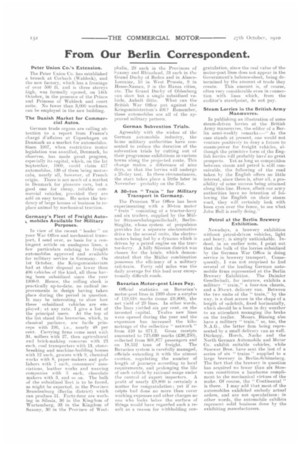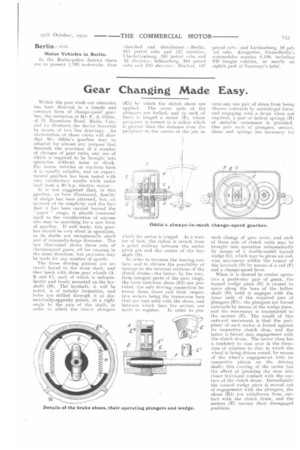From Our Berlin Correspondent.
Page 4

Page 5

If you've noticed an error in this article please click here to report it so we can fix it.
Peter Union Co.'s Extension.
The Peter Union Co. has established a branch at Corbach (Waldeck), and the new factory, which has a frontage of over 500 ft. and is three storeys high, was formally opened, on 14th October, in the presence of the Prince and Princess of Waldeck and court suite. No fewer than 3,000 workmen can be employed in the new building.
The Danish Market for Commercial Autos.
German trade organs are calling attention to a report from France's chargé d'affaires at Copenhagen on Denmark as a market for automobiles. Since 1907, when restrictive motor legislation was annulled, Denmark, he observes, has made great progress, especially its capital, which, on the 1st September, 1909, could claim 417 automobiles, 138 of them being motorcabs, nearly all, however, of French origin. There is not much of a market in Denmark for pleasure cars, but a good one for cheap, reliable commercial vehicles, provided they are sold on easy terms. He notes the tendency of large houses of business to replace animal by mechanical traction.
Germany's Fleet of Freight Auto', mobiles Available for Military Purposes.
In view of the recent " leader " On your War Office and mechanical transport, I send over, as basis for a contingent article on analagous lines, a few particulars relating to freight automobiles approved and available for military service in Germany, On fat October, the Kriegsministerium had at their disposal no fewer than 406 vehicles of the kind, all these having been subsklized since the year 1908-9. Hence, the rolling stock is practically up-to-date, no radical improvements in design having taken place during the period in question. It may be interesting to show how these subsidized vehicles are employed ; at any rate, I give a list of the principal users. At the top of the list stand the breweries, which, in classical parlance, are facile princeps with 396, i.e., nearly 48 per cent. Carrying firms come next with 34, millers with 27, then agricultural and briekonaking concerns with 23 each, coal transporters with 13, stonebreaking and machine-building houses with 12 each. grocers with 9, chemical works with 8, paper-makers and publishers with 7 each, consumers' associations, leather works and weaving companies with 5 each, chocolate makers with 3, and so on. The bulk of the subsidized 'fleet is to be found, as might be expected. in the Province Brandenburg (Berlin district) which can produce 51. Forty-four are working in Silesia, 36 in the Kingdom of Wurtemberg, 33 in the Kingdom of Saxony, 30 in the Province of West
phalia, 29 each in the Provinces of axony and Rhiueland, 23 each in the Grand Duchy of Baden and in AlsaceLorraine, 10 in West Prussia, 9 in Hesse-Nassau, 9 in the Hansa cities, etc. The Grand Duchy of Oldenburg can show but a single subsidized vehick, Anhalt ditto. What can the British War Office put against the iiriegsministerium's 406? Remember, these automobiles are all of the approved military pattern.
German Subvention Trials.
Agreeably with the wishes of the German automobile industry, the home military authorities have consented to reduce the duration of the subvention trials by cutting out of their programme exhibitions in various towns along the projected route. This change makes a difference of nine days, so that the lorries will undergo a 25-day test. In these circumstances, the start takes place a little later in November—probably on the 21st.
A 30-ton " Train " for Military Transport in Germany.
The Prussian War Office has been experimenting with a 30-ton motor " train " consisting of a tractor-lorry and six trailers, supplied by the Miiller Stra.s.senbahngesellschaft, BerlinSteglitz, whose system of propulsion provides for a separate electromotive drive to the seveial units, the electremotors. being fed by a dynamo which is driven by a petrol engine on the tractor-lorry. A hilly Silesian district was chosen for the trials, which demonstrated that the Milner combination possesses the efficiency of a military rail-train. Forty odd miles was the daily average for this load over exceptionally difficult roads.
Bavarian Motor-post Lines Pay.
Official statistics on Bavarian's motor-post lines in 1909 show a surplus of 119,616 marks (some S29,800), the net yield of 29 lines. In other words, the lines yielded six per cent. on the invested capital. Twelve new lines were opened during the year and the expansion has increased the kilometrage of the oolleetive " network " from 410 to 671.2. Gross receipts amounted to 725,030 marks (£36,250), collected from 801,877 passengers and on 18,552 tons of freight. The Bavarian system is carefully managed, officials extending it with the utmost caution. regulating the number of length of journeys according to local requirements, and prolonging the life of each vehicle by rational usage under the control of expert inspectors. A profit of nearly 0,800 is certainly a matter for congratulation ; yet if receipts had done no more than cover working Expenses and other charges no one who looks below the surface of things would have regarded such a resnit as a reason for withholding eon
gratulation, since the real value of the motor-post lines does not appear in the Government's balance-sheet, being determined by the amount of trade they
create. This amount. is, of course, often -very considerable even in connection with lines which, from the auditor's standpoint, do not pay.
Steam Lorries in the British Army Manoeuvres.
In publishing an illustration of some steam-driven lorries at the British Army maneeuvres, the editor of a Berlin semi-weekly remarks :—" As the ease stands at present, one would not venture positively to deny a future to steam-power for freight vehicles, although the primitive form ef.the English lorries will probably have no great prospects. Yet as long as competition between steam and petrol is still conceivable, the following of the road taken by the English offers no little interest, since there is, after all, a possibility of some Success being attained along this line. Hence, albeit our army authorities have no intention of following the English on their steam read, they will certainly look with keen eyes over the fence, to see what John Bull is really doing."
Petrol at the Berlin Brewery Exhibition.
Nowadays, a brewery exhibition without petrol-driven vehicles, light and heavy, is simply unthinkable. Indeed, in an earlier note, I point out that the bulk of the lorries subsidized by the German War Office is doing service in brewery transport. Consequently, I was not surprised to find several of the leading German automobile firms represented at the Berlin Brewery Exhibition. The Daimler Gesellschaft, for instance, exhibits a military " train," a four-ton chassis, and a 30-cwt. delivery van. Between the two units of the " train," by the way, is a dust screen in the shape of a length of sailcloth, fixed horizontally, which should be a boon in dry weather to an attendant managing the brake MI the trailer. Messrs. Bussing also have a military " train," so, too, the N.A.G., the latter firm being represented by a small delivery van as well. Dfirkopp, Horch, Nanke and the North German Automobile and Motor Co, exhibit suitable vehicles, while Stoewer Bre& have sent the last of a series of six " trains " supplied to a large brewery in Berlin-Scheneberg. The fact that the brewery in question has acquired no fewer than six Stoewers eonstitutes a handsome compliment to the mechanical virtues of the make. Of course, the " Continental " is there. I may add that Most of the automobiles exhibited embody actual orders, and are not speculations ; in other words, the automobile exhibits represent solid business done by the exhibiting manufacturers.
In the Berlin-police district there are at present 1,783 motoreabs, thus
i.lassilied and distributed :—Berlin, 81.5 petrol cabs and 127 eleetries; Charlottetiburg, 180 petrol cabs and 12 electrics; SchOneberg, 384 petrol cabs and 110 electrics ; Rixdorf. 137 petrol cabs; and Lichtenberg, 18 petrol cabs. Altogether. Gross-Berlin's automobiles number 6,100, ineludine 850 freight vehicles, or nearly an eighth part of Germany's total.




















